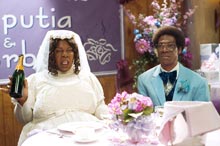For the past week or so — not counting an earlier skirmish — I’ve been embroiled in an argument over whether or not the 1923 Hunchback of Notre Dame with Lon Chaney is a great film, or nearly unwatchable rubbish. Has it been given a free pass because it stars Chaney, and because it’s really, really old? Or is it because the Grand Old Man of horror movie fandom, Forrest J. Ackerman, told all us Baby Boomer horror fans it was a great film in the pages of his magazine Famous Monsters of Filmland years before any of us actually saw the damned thing? (It will come as a surprise to no one, I’m sure, that I actually know people who will fight over an 85-year-old movie.)

While I freely admit that I’m in the “unwatchable rubbish” camp, that’s not the point of this. As almost always happens in any such argument … er, discussion … someone invoked the 90-percent rule, commonly known as “Sturgeon’s Law.” It states that 90 percent of everything is crap. The idea comes from science fiction writer Theodore Sturgeon, who was making a case specifically against criticism of sci-fi literature. Sturgeon claimed that it was easy to denigrate the genre by citing only the worst examples of it, noting that “90 percent of science fiction is crud, but then 90 percent of everything is crud.”
Of course, it’s an overstatement, but it’s such an irresistible overstatement. I mean, if you’ve spent an evening consisting of a double feature of Daddy Day Camp and Norbit (both from 2007), it’s impossible not to subscribe to this point of view, and even want to knock the percentage up a couple notches. But the concept itself started me thinking about how true it actually is or isn’t, so I took a look at a year’s worth of movie reviews — those from 2007.

By my reckoning, I wrote 169 reviews of new movies in 2007. My mind goes into 24 frames-per-second shock just thinking about that. And that’s not counting at least another 100 reviews of “special showing” movies for things like World Cinema, the Hendersonville Film Society, Walk-in Theater, etc. Nor am I including the competition entries for the Asheville Film Festival (there were 13 features in 2007). Toss in movies seen for pleasure and repeat viewings (come on, I sat though Across the Universe at least eight times in the theater — and it’s in the DVD player as we speak) and movies seen for other projects, and the list grows apace. (My less ardent admirers should take note that truly can it be said that I spend a lot of time in the dark.)
Now, there are certain drawbacks to this that make the results anything but scientific. Without actually counting them, we need to consider that my cohort, Justin Souther, averaged a review a week — and, as he and radio’s Matt Mittan never tire of pointing out — a great deal of what he gets handed is on the far side of choice. So let’s say that there were roughly 220 movies that played first-run theatrically in 2007, but let’s stick to my 169 for the moment. The breakdown is interesting.
I doled out 14 five-star reviews, 19 four-and-a-half-star reviews, a suprising 39 four-star reviews, and a respectable 24 three-and-a-half-star ones. There were also 16 three-star reviews, while 15 garnered two-and-a-half, 11 got two, five scored one-and-a-half, and single star and half star reviews tied at 13 each. That paints a considerably brighter picture of the state of film than evidenced by the 90-percent rule. And I’m not at all sure what this does my status as “cranky,” but that’s a separate question.
Based simply on the figures, there are a combined 33 five- and four-and-a-half-star reviews. That’s already more than 10 percent of the year’s total reviews, making hash of the 90-percent concept (actually, it’s 19.5 percent). Factor in 39 four- star reviews and we’re up to 72 reviews that could be counted as very positive, bringing the total to 42.6 percent for movies of some significant merit. The 24 three-and-a-half-star reviews — indicating a level of a degree of interest at least — represent another 14.2 percent. With 16 three-star reviews indicative of solid mediocrity, leaving us with 57 films — 34 percent — of little or no discernible merit. Looked at this way, things are perhaps not as bleak as they appear on the surface.
However, before we break out the Piper-Heidsieck, let’s remember that we can probably add another 20 to 30 titles of little or no merit if we factor in Mr. Souther’s entries. Moreover, it’s necessary to recognize the basic inadequacy of the whole star rating system.
Star ratings — and their variants like grades — are of little real value, but publishers like them because they present the reader with a quick guide to what is or isn’t good. (Publishers, it seems, believe that their readership doesn’t like to read too much.) Setting aside the fact that what is or isn’t good is pretty much a subjective call (the MTV Movie Awards voters picked Transformers as the best picture of 2007, which says much about the MTV audience), there’s the simple fact that not all stars are created equally. That’s not so true when dealing with five-star, and even four-and-a-half-star, movies. In those cases, it’s obvious that the reviewer thinks the film at hand is at least in the realm of the bee’s knees. Once you get past that, it’s another matter.
In the area of four-star reviews (assuming a five-star ceiling) things start to shift. Put simply those four stars I gave to Music and Lyrics and the four stars I gave to Inland Empire do not represent the same thing. The former is a perfectly fine piece of pop entertainment done with a degree of wit and heart. The latter is a seriously flawed, sometimes maddening work by a major filmmaker, David Lynch, that has moments of incandescent brilliance despite its shortcomings. Resurrecting the Champ is a pretty negligible film, but it contains a magnificent and fascinating performance by Samuel L. Jackson that propels it to the next level.

That’s really just the tip of the iceberg. Three-and-a-half-star reviews are even more troublesome in some ways, simply because a deeply, deeply flawed and rather silly film like the horror picture Dead Silence can be a lot more interesting than a perfectly competent, but stupefyingly dull movie like Fracture. Sometimes deeply flawed is better, but you’re never going to know that if you go by star ratings.
I first encountered the star-rating concept when I was a kid in a book called Movies on TV by Steven H. Scheuer. It was the precursor to the now more famous Leonard Maltin tomes. The book worked on a four-star system with half-star increments. It took pains to explain that four stars meant “excellent,” three stars meant “good,” two meant “fair,” and one meant “poor.” At the time all I could think of was what exactly three-and-a-half stars meant — good and a half? Looked at in that sense, it’s even sillier.
Another significant caution about taking the percentages I came up with are all that meaningful is that wonderful thing known as hindsight. With rare exceptions, movie reviews are written quickly. Chances are the reviewer saw the film at hand once and is having to turn in a final review of it within a day or so of seeing it. Looked at later, the praise may seem extravagant. I can go down the list of four star reviews for 2007 and spot at least ten titles, I’d knock down a half-star and maybe even a full star. Relativity plays a part in this. Ghost Rider is apt to look a lot better to you if you see it the same day you see Factory Girl. See my point?
However, with all these caveats to one side, I’m still concluding that movies are by and large a lot better than the 90-percent rule would allow. The funny thing about this is that 10 years ago, I wouldn’t have believed that — and you may not believe it now.
Here’s the point to that statement. Ten years ago my moviegoing was very selective. Even my stint reviewing movies for Films in Review back when it was a print magazine didn’t require seeing anything like the number of movies I now see. There’s a tendency to think of seeing a 169-plus movies a year as a bad thing — a fast-track to burn-out with a large degree of jadedness in the bargain. And there’s some justification for that school of thought, sure. You see enough movies and a certain amount of “been there, done that” is bound to creep in. Plot points can start to seem too similar and things that might be impressive in smaller doses — special effects are a prime candidate — are less so when you see a wide-range of movies.

That said, there are definite upsides to the situation, not the least of which is simply getting the feel for the overall picture of what’s being made. And there’s really no other way to get that sense than to see virtually everything that comes out. The surprise is just how much of it has some degree of worth. I see movies I would never think of seeing on my own hook that sometimes even become favorites. That’s hard to remember while watching Norbit or Primeval — or even such big deal movies as Transformers or I Am Legend — but taking a step back like this and looking at an entire year dispassionately, it’s no more than the truth to say that nowhere near 90 percent of the movies in that space of time are crap.
That’s the kind of thing that makes you wonder how true or not true “Sturgeon’s Law” is when applied more broadly — something to think about. But in case anyone is tempted to think I’m losing my much-touted crankiness, let me just say that easily 90 percent or more of the user comments — calling reviewers “douche bags,” “homos,” “a**holes,” etc. for not sharing the user’s views — on Rotten Tomatoes are indeed crap (and barely literate in the bargain). And the 1923 Hunchback of Notre Dame isn’t too far behind!
So there.



I won’t argue over the merits/demerits of Chaney’s HUNCHBACK OF NOTRE DAME with you. Suffice it to say that while it certainly isn’t the masterpiece that some people claim, I hold it in higher esteem than you do and have actually seen it a number of times and could easily watch it a number of times again. But to each his own.
I also have nothing but admiration and no little astonishment at the number of movies that you actually watch as well as the number of reviews that you are able to “crank” out. And then there’s the mini-essays and reflections like this one. I don’t always agree with what you have to say but I always enjoy hearing you say it in print.
What I really wanted to write about was Stephen H. Scheuer’s TV KEY MOVIE GUIDE as it was originally called. This was my first exposure to the 4 star rating system (which was shamelessly lifted by Leonard Maltin although he did add BOMB) and I prefer it to the 5 star system. I enjoyed the extra half stars employed as it seemed quite clear to me what he meant by them… 3 1/2 was not quite a classic but really good. 2 1/2 meant average while 1 1/2 meant not a complete waste of time. The one area where he was generally unreliable was with horror films. He usually didn’t like the contemporary ones and after he gave 1 star ratings to PEEPING TOM and CONQUEROR WORM aka WITCHFINDER GENERAL, I knew not to trust his judgement on those. Thanks for mentioning this forgotten pioneer who helped me to develop my critical faculties.
you give plenty of bad reviews, enough to retain the title “cranky”. and i do appreciate how 4 stars can mean different things – i think you do a fine job of accounting for a variety of tastes, and i find your reviews consistently useful.
and yeah, if 90% of what we made was pure crap, our society would have failed a long time ago. but it seems we do ok with 50% crap, eh?
you give plenty of bad reviews, enough to retain the title “cranky”.
Well, I see plenty of bad movies (and Justin informed me last night that since he had to review Superhero Movie I had to do the next in that series, Disaster Movie).
and i do appreciate how 4 stars can mean different things – i think you do a fine job of accounting for a variety of tastes, and i find your reviews consistently useful
Thank you. It’s of course impossible to account for every taste — and I’m not sure it would even have much value if you could since there’d be no standard — but it’s only reasonable to note that something is apt to appeal to someone even if it leaves you cold. And vice versa.
but it seems we do ok with 50% crap, eh?
Well, at least we bumble along on that basis, and it would be possible to take the approach that it’s simply amazing that we do as okay as we do. Still, it’d be nice if we could raise the percentage a bit.
God, this is the best example of classic irony I’ve come across in a long time. Not just a run-of-the-mill coincidence so many are prone to mistakenly confusing with irony.
“Ninety percent of everything is crap” is widely regarded as being a truism that’s only one-half of said Law…er, “Revelation.” Given the present context (“Sturgeon’s Law” having been invoked,) of one individual arbitrarily assigning numerical point value (begrudgingly, no doubt) to denote the interpreted value of art, the other half of Sturgeon’s axiom seems particularly prophetic in this circumstance—and, thusly, the other half invites the aforementioned paradox:
“Nothing is always absolutely so.”
I suspect this includes one’s—yours, mine, or ours—conclusion that 90% of the movies released in 2007 were NOT crap.
An entertaining piece.
What I really wanted to write about was Stephen H. Scheuer’s TV KEY MOVIE GUIDE as it was originally called.
I remember that now. And all in all, I think it was superior to Maltin’s later book(s). Also, I think it may have been all Scheuer, whereas Maltin never has been all Maltin, but Maltin and a horde of nameless reviewers. I think I understood the half-star concept at the time, but the idea of something being “poor and a half” still amuses me. It’s interesting to think back on this, because that book — along with Cal Beck’s magazine Castle of Frankenstein — probably had more to do with getting me to think in critical terms than anything. God knows, Famous Monsters may have introduced me to film, but it wasn’t exactly critical in any sense of the word. I remember wondering why the book ranked Road to Zanzibar a half-star higher than the other “Road” pictures, which actually caused me to think of the movies in comparative terms. (And damned if I didn’t find myself agreeing that instead of just good, it was good and a half.)
I suspect this includes one’s—yours, mine, or ours—conclusion that 90% of the movies released in 2007 were NOT crap.
Exactly, but there are times when it seems they must have been — until you actually start looking at the list.
>>I suspect this includes one’s—yours, mine, or ours—conclusion that 90% of the movies released in 2007 were NOT crap.
Oh, of course they were. Problem is, 90% of people *like* crap.
Oh, of course they were. Problem is, 90% of people *like* crap.
And I’m supposed to be the cranky one? Regardless, how many of the films that played here theatrically did you actually see? Even conceding the idea that you can probably tell that, say, NORBIT is irredeemable garbage without watching it, you’d need to slog your way through a pretty large number of the 2007 crop to make that statement in an informed manner.